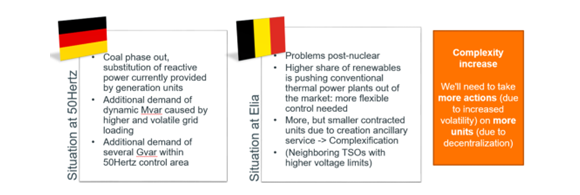31 May 2023
VoltControl: Bringing decision support into the control rooms
The goal of Voltcontrol tool is to understand and anticipate the foreseeable future, and propose different actions, to reach an optimal voltage plan of the high voltage grid.
Context
To support our system engineers with tackling the increasing complexity of managing the high voltage grid due to volatility, decentralisation and other changes, we created a decision support algorithm that will propose different actions, to optimize the grid voltage plan.
Why this project ?
As a transmission system operator, we are responsible for keeping the stability of the high voltage grid. The main aspects we are looking at are current, frequency and voltage.
In this VoltControl project, as the name gives away, we focused on tackling some of the upcoming challenges for voltage management. Given the decentralization of energy sources and the increasing volatility of generation and consumption, the System Engineers must make more decisions in a shorter period to regulate the grid voltage. Furthermore, conventional and significant sources of voltage management, such as nuclear and coal power plants, are being phased out for well-known reasons. This makes that the number of assets involved in each intervention will increase, again adding onto the complexity of voltage management.
To support our system engineers with tackling this upcoming and increasing challenge, we decided to create a decision support algorithm.

Approach
- Locality results from the fact that the voltage of the grid is a local problem, in which assets that are located further from the issue have less impact. Therefore, by limiting the calculation space, a big part of the complexity can be reduced. For this approach to work properly, we need to establish the electrical distance at which an action still has an important influence.
- Linearity avoids the need of making many calculation-intensive AC load flow calculations, by approximating the AC voltages using a linear calculation. Of course, at crucial steps during the calculation and at the end, an exact AC load flow is performed, but during intermediate steps the linear approximation is sufficient to reach an optimal solution faster. ¹
- The forward-looking component means that the full relevant timeframe is calculated as one single optimization problem, rather than making a sequential calculation which requires the optimizer to jump back and forth to ensure a continuous flow of proposed actions.
The prototype
These three ingredients together have led us to creating a prototype of the VoltControl tool, which is able to read grid data of upcoming subsequent timesteps and make hourly proposals to the system engineer.
In big lines, the architecture of the prototype looks as follows:
- We start with an extraction of CGMES data out of the conventional calculation environment, and we feed it into the open source pandapower tool;
- Additional data, not native to the CGMES format, is fed into the pandapower model using pre-processing python scripts;
- Scenario data is added to the pandapower grid;
- Steered by a pre-compiled config file, the optimization code is run using all the created input files. Here, the different mathematical and optimization manipulations are performed
- The output of the optimizer is then fed into a post processing script, leading to a result file consisting of the proposals towards the optimal voltage plan.
Concretely, these proposals are a list of actions that can be taken, such as changing a generator setpoint, connecting a grid element, or changing the tap position of a transformer.
In line with the chosen objective function, applying these proposals would lead to a grid with minimal voltage deviations of the target values, with maximum free dynamic flexibility, and at the lowest cost. The objective function can of course be tuned according to specific needs, to favour one or the other element or to optimize another objective.
Of course, if the prototype would be introduced as such into the control room, the proposals will need to be carefully considered by the system engineer. It is evident that the system operator keeps responsibility and full control over the high voltage grid.
This does not hinder, however, a future in which we can imagine a solution that acts such as the autopilot of an airplane: taking decisions and applying them automatically if nothing exceptional happens, and able to be overruled by the human operator at all times. This could lead to a state of ‘supervised automation’ for the high voltage grid.
Results and next steps
The results of the tests are promising. Grid experts and system engineers have assessed the proposals made by the tool and confirmed that applying the proposals indeed leads to an improvement of the situation. The tool often proposes the most logic solutions, which makes it trustworthy and interesting to assess the solution further. This means that the track towards industrialization is open. In Belgium, the goal would be to have the tool operational by the winter of 24/25, because this is foreseen to be a hard winter. In Germany, a similar timing is aimed for.
On top of the discussed features, meaning that the tool can interpret current and upcoming grid state and optimize these according to a set objective function, in the future we want to add other possibilities. One of these would be the possibility of interaction and introducing specific setpoints as an extra constraint to the optimization. Additionally, integrating other objectives into the tool, such as congestions, will be studied as a next step (learn more here: fast grid topology reconfiguration). This will bring us closer to the ultimate vision of building an autopilot which is able to support with all aspects of the system operation processes
¹ In comparison with DC approximation, Voltcontrol’s linear approximation takes into account active power, reactive power and voltage deviations.
Partners
 |
 |



